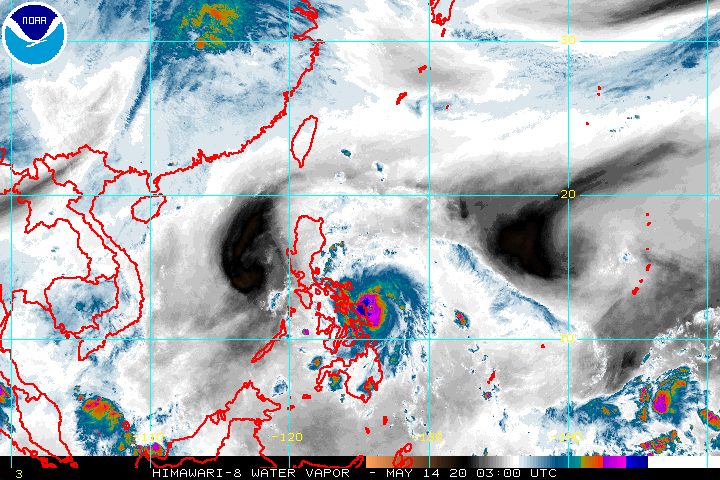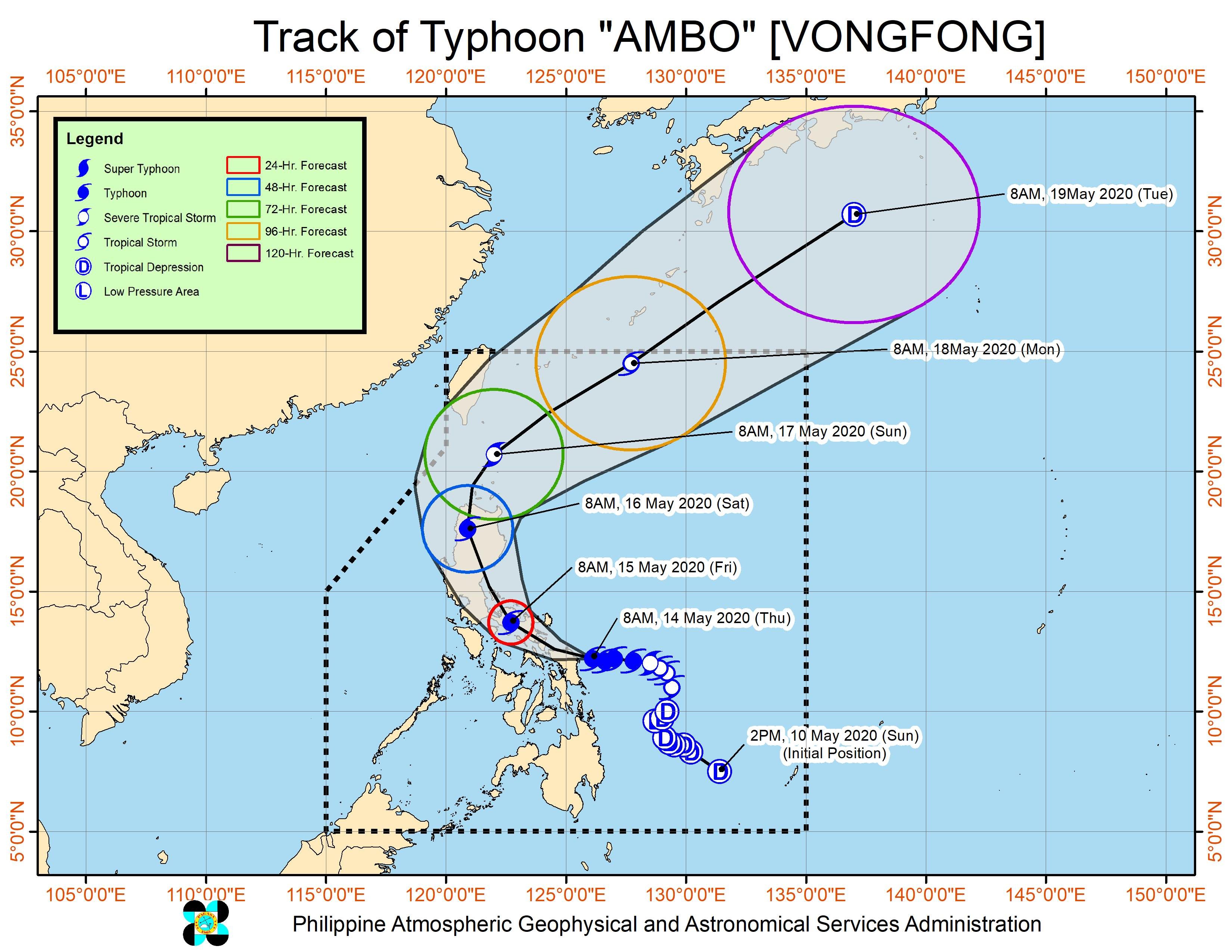SUMMARY
This is AI generated summarization, which may have errors. For context, always refer to the full article.

What’s the weather like in your area? Tweet us at @rapplerdotcom.
MANILA, Philippines – Typhoon Ambo (Vongfong) is expected to make landfall either in Northern Samar or in the northern part of Eastern Samar between 12 pm and 2 pm on Thursday, May 14.
In a press briefing past 11 am on Thursday, the Philippine Atmospheric, Geophysical, and Astronomical Services Administration (PAGASA) said Ambo is now 140 kilometers east southeast of Catarman, Northern Samar.
The typhoon continues to move west at 15 kilometers per hour (km/h).
It also maintained its strength, with maximum winds of 155 km/h and gustiness of up to 190 km/h. (READ: FAST FACTS: Tropical cyclones, rainfall advisories)
As Ambo is nearing land, more areas were placed under Signal Nos. 1, 2, and 3. Below is the latest list. (READ: Why is it now called tropical cyclone ‘wind’ – and not ‘warning’ – signals?)
Signal No. 3 (winds of 121 to 170 km/h, or strong to destructive typhoon-force winds during the passage of the typhoon)
- Sorsogon
- Albay
- Ticao Island
- Northern Samar
- northern part of Eastern Samar (Jipapad, Arteche, Maslog, Dolores, Oras, San Policarpio, Can-avid, Taft, Sulat, San Julian, Borongan City, Maydolong)
- northern part of Samar (Calbayog City, Sta Margarita, Gandara, Pagsanghan, San Jorge, Matuguinao, San Jose de Buan, Catbalogan City, Jiabong, Motiong, Paranas, Tarangnan, San Sebastian, Hinabangan)
Signal No. 2 (winds of 61 to 120 km/h, or strong to damaging gale-/storm-force winds during the passage of the typhoon)
- southern part of Quezon (Pagbilao, Atimonan, Padre Burgos, Plaridel, Agdangan, Unisan, Gumaca, Pitogo, Macalelon, Lopez, Caluag, General Luna, Catanauan, Perez, Alabat, Quezon, Tagkawayan, Guinayangan, Buenavista, San Narciso, Mulanay, San Andres, San Francisco)
- Camarines Norte
- Camarines Sur
- Catanduanes
- Burias Island
- mainland Masbate
- Marinduque
- Biliran
- rest of Samar
- rest of Eastern Samar
Signal No. 1 (winds of 30 to 60 km/h, or strong to near-gale-force winds during the passage of the typhoon)
- Aurora
- southern part of Nueva Ecija (General Mamerto Natividad, Palayan City, Cabanatuan, Santa Rosa, Jaen, San Isidro, San Antonio, Cabiao, Bongabon, Gabaldon, General Tinio, Laur, San Leonardo, Peñaranda, Gapan City)
- Bulacan
- Metro Manila
- Cavite
- Laguna
- Batangas
- Rizal
- rest of Quezon
- Romblon
- Bataan
- Pampanga
- northern part of Leyte (Calubian, San Isidro, Tabango, Villaba, Leyte, Kananga, Capoocan, Carigara, Barugo, San Miguel, Babatngon, Tunga, Jaro, Alangalang, Sta Fe, Tacloban City, Palo, Pastrana, Dagami, Tabontabon, Tanauan, Tolosa, Ormoc City, Matag-ob, Palompon, Merida, Isabel, Albuera, Burauen, Julita, Dulag)
“Violent winds and heavy to torrential rain of the eyewall region will begin affecting Northern Samar and the northern portions of Samar and Eastern Samar within 12 hours,” PAGASA warned.
The state weather bureau also gave this updated rainfall outlook:
Thursday, May 14
Heavy to intense rain, with at times torrential rain
- Northern Samar
- Eastern Samar
- Samar
- Masbate
- Sorsogon
- Catanduanes
Moderate to heavy rain, with at times intense rain
- Albay
- Camarines Sur
- rest of Eastern Visayas
Friday, May 15
Heavy to intense rain, with at times torrential rain
- Bicol
Moderate to heavy rain, with at times intense rain
- Northern Samar
- Quezon
- Aurora
- Marinduque
- Romblon
Floods, landslides, and even lahar from Mayon Volcano are possible. The Philippine Institute of Volcanology and Seismology issued an advisory on Wednesday, May 13, warning that rainfall from Ambo might mix with volcanic deposits from Mayon’s 2018 eruption, which could result in lahar or volcanic mudflows.
The typhoon may also cause storm surges 2 to 4 meters high within 24 hours. These areas should be on alert for “potentially life-threatening coastal inundation”:
- Northern Samar
- Eastern Samar (east coast)
- Samar (west coast)
- Sorsogon
- Albay
- Catanduanes
- Camarines Sur
- Camarines Norte
- Quezon
- Aurora
Sea travel is risky for all vessels in the seaboards of areas under tropical cyclone wind signals.
As for Metro Manila, PAGASA Senior Weather Specialist Chris Perez said that for now, it will not be directly hit by Ambo. But due to Ambo’s diameter, the capital region may also experience some rain and winds triggered by the typhoon.
Perez also said PAGASA is not ruling out the possibility that the tropical cyclone wind signal for Metro Manila may be raised to Signal No. 2.

Ambo is the Philippines’ first tropical cyclone for 2020. The country gets an average of 20 tropical cyclones per year. (READ: LIST: PAGASA’s names for tropical cyclones in 2020)
In PAGASA’s climate outlook, it gave the following estimates for the number of tropical cyclones in the next 6 months:
- May – 1 or 2
- June – 1 or 2
- July – 2 to 4
- August – 2 or 3
- September – 2 or 3
- October – 2 or 3
While bracing for Ambo, the Philippines is also combating the coronavirus outbreak. The number of COVID-19 cases in the country climbed to 11,618 on Wednesday. – Rappler.com
Add a comment
How does this make you feel?
There are no comments yet. Add your comment to start the conversation.